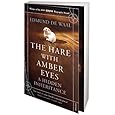"264 wood and ivory carvings, none of them larger than a matchbox: potter Edmund de Waal was entranced when he first encountered the collection in the Tokyo apartment of his great uncle Iggie. Later, when Edmund inherited the ‘netsuke’, they unlocked a story far larger than he could ever have imagined…"
--The review--
Moved to read this tome for its mentions of Proust (due to working through the big guy's opus as we speak - last volume now!), I was left upon finishing with a sense and knowledge of so much more. Edmund de Waal's work received an award for biography, but it is not quite a memoir - it is more than this. Having received recommendations of the book from my mother and sister, and gone on to enjoy it myself, proves via our different spectra of abilities and interests that it is readable, accessible, and interesting to very many. The author therefore does what many in the past have failed to do by bringing history and art history to the masses, binding these interests together perfectly with political and personal histories.
Skilled and sensitive, The Hare With Amber Eyes is driven by the sheer dedication of its author, and the depth of research that has gone into it is of clearly phenomenal levels. Images are used carefully to gently enhance enjoyment, rather than bombarding the reader, and the concision of the prose is equally commendable. The choice of the hare in the title is perhaps not necessarily apparent (after all, there are 264 netsuke to choose from, so why pick that one?), but this does not seem to matter. The book is also a travel book, in that it compels you to want to visit the places described - Odessa, Paris, Vienna and other locations are brought to life with vivacity and tenacity.
That the main themes in the book should be the nature of memory, storytelling and oral tradition (not AURAL, I'm afraid, Edmund), art, the making of things, and passing things down make it no surprise that the story's principal message should be that it's how you tell the story that matters - it's no good simply having these objects without knowing where they have come from, and certainly in the hands of a lesser author the story itself may have become devalued by being passed down to us as a readers in an inferior manner. It is perhaps here that the choice of a hare with amber eyes comes into significance - the use of amber as a way to preserve something old within something new exemplifies the purpose of the writer's story, which he states is to encase the story in something new for his children.
The inheritance referred to on the cover of the book is naturally not only the physical inheritance of the netsuke but the legacy of the family history, and it is told in such a way as to be pleasantly cyclical. Further strengths include the honesty, detail and humour with which family members are portrayed, and the accessibility with which various complex issues are approached. Familiarities such as Impressionism and Nazi Europe are made new for us, and de Waal's arguably overambitious scope is approached and fulfilled with deftness and modesty.
De Waal's mastery of all aspects of storytelling is what makes this true tale what it is; a rich fiction, but in the most positive possible way. Determined and moving without being slushy, it is practically perfect in every way - absorbing, intellectual, down-to-earth, humorous, and written with real feeling.













